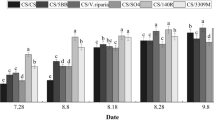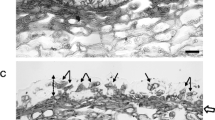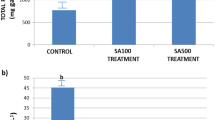Abstract
Early foliar spray treatments containing gibberellic acid(GA3) significantly lower the concentration ofthe bitter flavonoid naringin in fruit tissues. Sprayscontaining a surfactant and different levels ofGA3 (5, 50, 100, and 500 ppm) or abscisic acid(ABA) (5, 25, and 50 ppm) were applied to young,developing fruit on mature grapefruit (Citrusparadisi) trees during the period from April to June,beginning just after fruit set. The fruit were allowedto mature and were harvested early the following year.Harvested fruit were evaluated for weight, juicecharacteristics, and flavonoid concentrations.GA3 application resulted in larger mature fruit,which yielded juice with the same soluble solids valueas juice from control fruit, but with slightly loweracid percentages and lower concentrations of naringin.ABA treatment had little effect on juice solublesolids, acid content and naringin content except atthe highest concentration of 50 ppm, which lowerednaringin levels slightly in juice.
Similar content being viewed by others
References
Albach RF, Juarez AT and Lime BJ (1969) Time of naringin production in grapefruit. J. Amer. Soc. Hortic. Sci 94: 605-609
Albach RF and Redman GH (1969) Composition and Inheritance of Flavanones in Citrus Fruit. Phytochem. 8: 127-143
Albach RF, Redman GH, Cruse RR and Petersen HDV (1981) Seasonal variation of bitterness components, pulp, and vitamin C in Texas commercial citrus juices. J. Agri. Food Chem 29: 805-808
Albach RF, Redman GH and Cruse RR (1981) Annual and seasonal changes in naringin concentration of Ruby Red grapefruit juice. J. Agric. Food Chem 29: 808-811
Albach RF and Wutscher HK (1988) Flavanone content of whole grapefruit and juice as influenced by fruit development. J. Rio Grande Valley Hortic. Soc 41: 89-95
Arriaga FJ and Rumbero A (1990) Naringin, hesperidin and neohesperidin content in juices from thirteen Citrus spp. Fitoterapia 61: 31-36
Attaway JA (1977) Factors influencing the flavor of grapefruit juice. Proc. Intern. Soc. Citricult 3: 816-820
Benavente-Garcia O, Castillo J and del Rio Conesa JA (1993) Changes in neodiosmin levels during the development of Citrus aurantium leaves and fruits. Postulation of a neodiosmin biosynthetic pathway. J. Agric. Food Chem 41: 1911-1919
Berhow M, Tisserat B, Kanes K and Vandercook C (1998) Survey of Phenolic Compounds Produced in Citrus, Technical Bulletin Number 1856, USDA, ARS: Washington, DC
Berhow MA and Vandercook CE (1989) Biosynthesis of naringin and prunin in detached grapefruit. Phytochem. 28: 1627-1630
Berhow MA and Vandercook CE (1991) Sites of naringin biosynthesis in grapefruit seedlings. J. Plant Physiol 138: 176-179
Berhow MA and Vandercook CE (1992) The reduction of naringin content of grapefruit by applications of gibberellic acid. Plant Growth Regul 11: 75-80
Castillo J, Benavente O and del Rio JA (1992) Naringin and neohesperidin levels during development of leaves, flower buds, and fruits of Citrus aurantium. Plant Physiol. 99: 67-73
Castillo J, Benavente O and del Rio JA (1993) Hesperetin 7-O-glucoside and prunin in Citrus species (C. aurantium and C. paradisi). A study of their qualitative distribution in immature fruits and as immeadiate precursors of neohesperidin and naringin in C. aurantium. J. Agric. Food Chem 41: 1920-1924
Coggins CW, Jr and Henning GL (1988) Grapefruit rind blemish caused by interaction of gibberellic acid and wetting agents. In: Goren R and Mendel K (eds) Proceedings of the Sixth International Citrus Congress, Vol. 2, Tel Aviv: Balaban Publ, pp. 333-338
Coggins CWJ and Henning GL (1988) A comprehensive California field study of the influence of preharvest applications of gibberellic acid on the rind quality of valencia oranges. Israel J. of Bot 37: 145-154
Del Rio JA, Fuster MD, Sabater F, Porras I, García-Lidón A and Ortuño A (1995) Effect of benzylaminopurine on the flavanones hesperidin, hesperetin 7-O-glucoside, and prunin in tangelo nova fruits. J. Agric. Food Chem 43: 2030-2034
El-Otmani M, Lovatt CJ, Coggins CWJ and Agusti M (1995) Plant growth regulators in citriculture: factors regulating endogenous levels in citrus tissues. Crit. Rev. Plant Sci 14: 367-412
Fisher JF (1968) A procedure for obtaining radioactive naringin From grapefruit leaves fed L-phenylalanine-14C. Phytochem. 7: 769-771
Goldschmidt EE and Galili D (1981) Fate of 14-C-gibberellic acid in senescing on-tree 'valencia' orange fruit. J. Amer. Soc. Horticult. Sci 106: 175-177
Goldschmidt EE (1983) Asymmetric growth of citrus fruit peel induced by localized application of gibberellins in lanolin pastes. Scient. Horticult 21: 29-35
Goren R, Monselise SP and Ben Moshe A (1976) Control of corky (silvery) spots of grapefruit by growth regulators. HortScience 11: 421-422
Greany PD, McDonald RE, Shaw PE, Schroeder WJ, Howard DF, Hattan TT, Davis PL and Rasmussen GK (1987) Use of gibberellic acid to reduce grapefruit susceptibility to attack by the Caribbean fruit fly Anastrepha suspensa (Diptera: Tephritidae). Trop. Sci 27: 261-270
Greenberg J and Goldschmidt EE (1988) The effectiveness of GA3 application to citrus fruit. In: Goren R and Mendel K (eds) Proceedings of the Sixth International Citrus Congress, Vol. 1, Tel Aviv: Balaban Publ, pp. 339-342
Greenberg J and Goldschmidt EE (1989) Acidifying agents, uptake, and physiological activity of gibberellin A3 in citrus. Hort Science 24: 791-793
Greenberg J and Goldschmidt EE (1990) Uptake of 14-C-gibberellic acid by mature grapefruit (Citrus paradisi Macf.) as affected by relative humidity and method of application. Ann. Appl. Biol 116: 383-390
Greenberg J and Goldschmidt EE (1990) Persistance of 14-C-gibberellin A3 on the surface of citrus fruit peel and on inert glass surfaces. Plant Growth Reg 9: 215-226
Guadagni DG, Maier VP and Turnbaugh JG (1973) Effect of some citrus juice constituents on taste thresholds for limonin and naringin bitterness. J. Sci. Food and Agric 24: 1277-1288
Guadagni DG, Maier VP and Turnbaugh JG (1974) Some factors affecting sensory thresholds and relative bitterness of limonin and naringin. J. Sci. Food Agric 25: 1199-1205
Hagen RE, Dunlap WJ and Wender SH (1966) Seasonal variation of naringin and certain other flavanone glycosides in juice sacs of Texas Ruby Red grapefruit. J. Food Sci. 31: 542-547
Hammerschmidt R (1993) The nature and generation of systematic signals induced by pathogens, arthropod herbivors, and wounds. Adv. Plant Path 10: 307-337
Hasegawa S and Maier VP (1981) Some aspects of citrus biochemistry and juice quality. Proc. Int. Soc. Citriculture 2: 914-918
Hildmann T, Ebneth E, Peña-Cortés H, Sánchez-Serrano JJ, Willmitzer L and Prat P (1992) General roles of abscisic and jasmonic acids in gene activation as the result of mechanical wounding. Plant Cell 4: 1157-1170
Horowitz RM (1986) Taste Effects of Flavonoids. In: Cody V, Middleton EJ and Harborne JB (eds), Plant Flavonoids in Biochemistry and Medicine: Biochemical, Pharmacological, and Structure-Activity Relationships. New York: Alan R. Liss, Inc. pp 163-175
Horowitz RM and Gentili B (1977) Flavonoid constituents of Citrus. In: Nagy S, Shaw PE and Velhuis MK (eds) Citrus Science and Technology, Westport, CT: AVI Publishing Company, Inc. pp. 397-426
Jourdan PS, McIntosh CA and Mansell R L (1985) Naringin levels in citrus tissues. II. Quantitative distribution of naringin in Citrus paradisi Macfad. Plant Physiol 77: 903-908
Kanes K, Tisserat B, Berhow M and Vandercook C (1993) Phenolic composition of various tissues of Rutaceae species. Phytochem. 32: 967-974
MacDonald RE, Greany PD, Shaw PE, Schroeder WJ, Hatton TT and Wison CW (1988) Use of gibberellic acid or Caribbean fruit fly (Anastrepha suspensa) control in grapefruit. In: Goren R and Mendel K (eds) Proceedings of the Sixth International Citrus Congress, Vol. 2, Tel Aviv: Balaban Publ, pp. 1147-1152
Matsumoto R and Okudai N (1986) Inheritance of flavanone glycosides in citrus fruit juice. Bull. Fruit Tree Res. Sta. Japan, D Kuchinotsu 8: 112
Matsumoto R and Okudai N (1991) Inheritance of flavanone neohesperidoside in Citrus. J. Japan. Soc. Hortic. Sci 60: 201-207
Matsumoto R, Okudai N and Maotani T (1983) Changes in naringin content of natsumikan fruit (Citrus natsudaidai Hayata, cv. Kawano-natsudaidai) after freezing [Injury]. J. Jap. Soc. Hortic. Sci 52: 1-6
Mauer RH, Burdick EM and Waibel CW (1950) Distribution of naringin in Texas grapefruit. Proc. Rio Grande Valley Hortic. Inst 4: 147-151
Rössler Y and Greany PD (1990) Enhancement of citrus resistance to the Mediterranean fruit fly. Entomol. Exp. Appl 54: 89-96
Rouseff RL, Martin SF and Youtsey CO (1987) Quantitative survey of narirutin, naringin, hesperidin, and neohesperidin in Citrus. J. Agri. Food Chem 35: 1027-1030
Shaw PE, Calkins CO, McDonald RE, Greany PD, Webb JC, Nisperos-Carriedo MO and Barros SM (1991) Changes in limonin and naringin levels in grapefruit albedo with maturity and the effects of gibberellic acid on these changes. Phytochem. 30: 3215-3219
Stafford H. (1990) Flavonoid Metabolism. Boca Ratan: CRC Press, Inc.
Vandercook CE and Tisserat B (1989) Flavonoid changes in developing lemons grown in vivo and in vitro. Phytochem. 28: 799-803
Wilson WC (1983) The uses of exogenous plant growth regulators on citrus. In: Nickell LG (ed) Plant Growth Regulating Chemicals, Boca Raton, LA: CRC Press, pp. 207-232
Wilson WC (1984) Plant growth regulator uses in citrus. In: Ory RL and Rettig FR (eds) Bioregulators: Chemistry and Uses. Washington, DC: American Chemical Society. pp. 113-126
Zhu XR and Matsumoto K (1987) Absorbtion and translocation of 6-benzylamino purine in Satsuma (Citrus unshiu Marc.) trees. J. Japan. Soc. Hortic. Sci 56: 159-165
Author information
Authors and Affiliations
Rights and permissions
About this article
Cite this article
Berhow, M.A. Effects of early plant growth regulator treatments on flavonoid levels in grapefruit. Plant Growth Regulation 30, 225–232 (2000). https://doi.org/10.1023/A:1006349108636
Issue Date:
DOI: https://doi.org/10.1023/A:1006349108636




